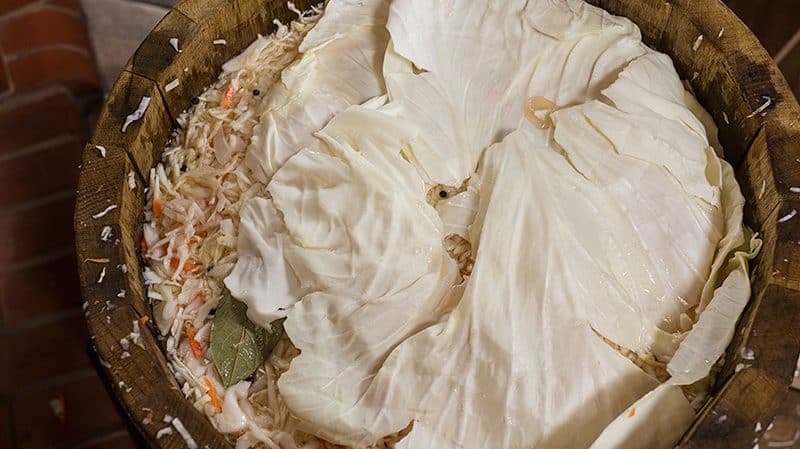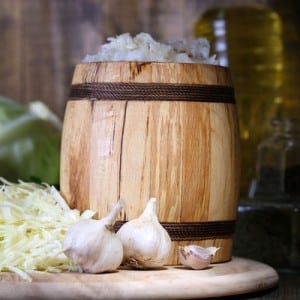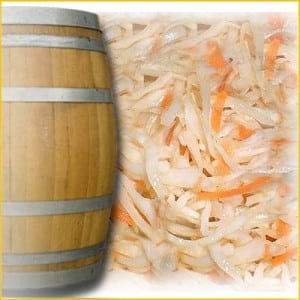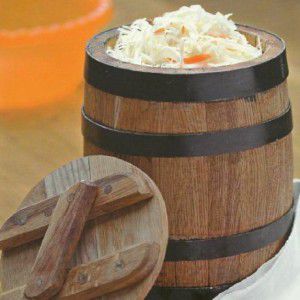The most delicious recipes for sauerkraut in a tub - you'll lick your fingers!
Salted cabbage in wooden tubs is a snack for lovers of Russian cuisine. It is prepared according to a traditional recipe, adding garlic, cranberries or horseradish. The cabbage turns out crispy and aromatic, retaining its benefits. The appetizer is served on the table with side dishes, soups and black bread.
In this article, we will look in detail at popular recipes for sauerkraut in a tub and find out in which container it is best to ferment it.
Selection and preparation of cabbage for sourdough
For sourdough, select small, healthy heads of cabbage with white leaves, elastic and hard, without spots or dark stripes. When purchasing, the head of cabbage is inspected from all sides, checked for damage and defects. It is better to use mid-season varieties - they are stored for a long time and do not lose their nutritional properties. Housewives choose the varieties Podarok, Slava, Dobrovodskaya, Megaton, Kupchikha.
Before fermenting, the vegetable is washed under cool running water, the top leaves are removed and the stalk is removed. Experienced cooks do not throw away the leaves, but freeze them in the freezer and later use them to make cabbage rolls.
The head of cabbage is cut into several parts, each of which is chopped with a knife, chopped on a special vegetable grater or processed through a food processor.
Preparing containers
The shelf life of the product and its taste depend on the preparation of the container. Before fermenting, wooden tubs and barrels are filled with boiling water and covered with a lid for 15 minutes.Then drain and fill with clean cold water for 20 days, changing it every 3 days. The water is drained, after drying the barrel is fumigated with sulfur and washed thoroughly.
Important! It is recommended to use oak tubs. They are resistant to fungi and mold, moisture and crumbling. The tree produces tannin, which is beneficial for humans. Oak also gives cabbage a pleasant flavor and woody aroma. Compact planters take up little space and decorate any pantry or basement.
How to properly ferment cabbage in a tub - a classic recipe

This appetizer is served at the dinner table or at a holiday celebration.
List of ingredients:
- 5 kg cabbage;
- 1 kg carrots;
- 3 liters of water;
- 200 g stone salt;
- cumin to taste.
Cooking technology:
- Peel the cabbage from the top leaves, remove the stalk. Rinse whole, healthy leaves under cool water and set aside. Cut the head of cabbage into several pieces and chop finely with a knife.
- Wash the carrots and remove the peel. Grind on a medium grater and mix with cabbage. Mash the vegetable mixture with your hands and transfer to a deep bowl.
- Place whole cabbage leaves on the bottom of the tub or barrel, and put shredded vegetables on top. Salt and add cumin.
- Prepare the brine: mix water with salt and pour into a tub.
- Cover with leaves and store under a load for 3-4 days in a warm place. After a day, foam forms on the surface.
- Every day, pierce the snack with a wooden spatula to release gases and process pickling passed more evenly.
- Before use, take the open tub out into the air for a couple of hours. The appetizer is ready.
Recipe Variations
Pickles have different variations. Fans of spicy foods add horseradish and garlic to the dish. Fans of sweet and sour flavors will love the zesty and colorful cranberries.To make the snack tasty and healthy, you must follow recipe preparation and fermentation time.
In Armenian
Beetroot is used for cooking - it saturates the dish with useful substances and creates an appetizing purple-red color. Armenian sauerkraut is good both as an addition to the main dish and as an independent snack.
Ingredients:
- 3 kg cabbage;
- 500 g beets;
- 600 g carrots;
- fresh herbs to taste;
- 3 red peppers;
- 5 bay leaves;
- 60 g salt;
- 5 g cinnamon;
- 1.5 liters of water;
- 100 g cherry leaves.
How to cook:
- Prepare the brine: add salt, cinnamon, aromatic spices and herbs to taste to the water. Stir and place on the stove. Bring to a boil, add bay leaf and cool.
- Rinse the vegetables and wipe dry. Peel carrots and beets and cut into thin slices.
- Place whole cabbage leaves and cherry leaves scalded with boiling water on the bottom of the tub. Place large pieces of cabbage on top.
- Place carrots and beets between the rows, add chopped red pepper and garlic to taste, and fresh herbs.
- Cover with cabbage leaves on top, pour in brine and put under pressure for 5 days in a warm place.
- Transfer the tub to a cool place for another 2 days. Armenian cabbage is ready.
With cranberries
This snack will strengthen your immune system in the fall and winter and protect you from the flu virus and colds.
What you need for preparation:
- 2 kg cabbage;
- 300 g carrots;
- 200 g fresh frozen cranberries;
- 5 g cumin;

- 40 g salt;
- 10 g Sahara.
How to ferment:
- Wash the cabbage, remove the top leaves and stalks. Cut into several parts, finely chop each one.
- Peel the carrots, rinse and chop. Do not defrost cranberries.
- Sprinkle the chopped cabbage with salt and sugar and rub with your hands.Add salt and cumin, stir again. Add cranberries and carrots.
- Place cabbage leaves at the bottom of the barrel, followed by a cabbage-carrot mixture with cranberries.
- Cover with a clean napkin and lid, put under a press. Place in a warm place for 1.5 weeks, periodically pierce with a wooden spatula. If a lot of juice has formed, scoop it out and pour it away.
- During the fermentation process, vegetables should always be covered with brine. Winter vegetable salad with cranberries is ready.
With horseradish and garlic
The preparation with horseradish and garlic is universal, suitable for any dishes: side dishes, soups and salads. It has a spicy taste and rich aroma. What you will need:
- 1 kg cabbage;
- 300 g carrots;

- 10 g horseradish;
- 6 cloves of garlic;
- 1.5 liters of water;
- 60 g salt;
- 40 g sugar;
- 5 black peppercorns;
- 10 ml vinegar;
- 3 blackcurrant leaves;
- 5 cherry leaves.
How to cook:
- Wash the cabbage, chop and mash with your hands.
- Peel the carrots and chop them together with the horseradish root on a medium grater. Pass the garlic through a press. Mix the ingredients.
- Add salt, black peppercorns, vinegar and sugar to the water and mix.
- Scald blackcurrant and cherry leaves with boiling water. Place on the bottom of the tub, put a layer of cabbage on top, then add horseradish and garlic, followed by carrots. Repeat the sequence again.
- Cover the cabbage with cherry leaves and pour brine over it. Cover with a cloth and put under pressure for 4 days.
- Pierce it daily with a wooden spatula and remove the foam. The cabbage is ready.
Whole heads of cabbage
Cabbage heads have a crispy taste - the pieces are evenly soaked in brine. Select small specimens - the approximate weight of a head of cabbage is about 1-2 kg. List of ingredients:
- 1 kg cabbage;

- 700 ml water;
- 5 cloves of garlic;
- 100 g salt.
How to cook:
- Clean the head of cabbage and wash the top leaves. Cut large heads of cabbage into two parts, salt small ones whole.
- Place cabbage leaves on the bottom of the tub and a head of cabbage on top. Pour brine (water + salt), add peeled garlic cloves to the tub.
- Cover with a napkin and weight, leave at room temperature for 7 days.
- Cabbage is ready to eat.
Whole cabbage is fermented with the addition of mushrooms, parsnips, carrots, beets, and bell peppers.
How and with what to serve this cabbage
Spicy sauerkraut with garlic and horseradish is served with meat dishes - shish kebab, cutlets, goulash. The appetizer goes well with delicacies of Russian, Georgian, Armenian, and Korean cuisines. If you don’t want to or don’t have time to cook dinner, then you can simply snack on black bread or pita bread with such cabbage. It turns out tasty and nutritious.
The dish is served with potato, vegetable, buckwheat and rice side dishes. Cabbage and cranberries go harmoniously with fish, especially if you sprinkle it with lemon juice. Mushroom lovers prepare holiday salads by adding the spicy preparation.
Attention! Before serving, cool the cabbage in the refrigerator. The appetizer looks beautiful decorated with pine nuts, fresh herbs or lingonberries.
Terms and conditions of storage
Bulk wooden barrels are stored in a cellar or basement - they take up a lot of space. Compact tubs are placed in the refrigerator. Recommended air temperature is from 0°C to -4°C, air humidity is about 85%. You cannot store the tubs near a radiator or in the sun - due to the heat, the cabbage will ferment and quickly deteriorate.
Experienced housewives recommend regularly inspecting the preparations: if the brine is cloudy, you need to add sugar. It acts as a natural preservative and slows down the spoilage process.The snack can be stored in wooden tubs for up to six months.
Advice from experienced housewives
To ensure that winter preparations retain their taste and benefits, we recommend following the advice of experienced housewives:
- Cabbage is fermented in the fall - after harvesting. The first cabbage from the garden is the most delicious and juicy, and can be stored for a long time.
- A clean stone or a three-liter jar of water is used as oppression.
- To prepare the brine, use coarse rock salt; iodized salt is not suitable - it will make the vegetables soft.
- When fermenting whole cabbage, make a cross-shaped cut on the head of cabbage so that the vegetable is salted evenly.
- To make cabbage crunchy, soak it in cold water for 30 seconds before shredding.
- To protect the preparations from mold, horseradish leaves scalded with boiling water are placed at the bottom of the barrel.
Conclusion
To make the preparations juicy and healthy, it is recommended to ferment them in an oak tub. Oak is strong and has antiseptic properties. Both whole heads of cabbage and finely chopped ones are harvested. For taste and color, carrots or beets, fresh herbs or red peppers, cranberries or lingonberries are added to dishes.
Cabbage is fermented under pressure, using a clean stone and a napkin. During fermentation, vegetables are pierced with a wooden spatula - this allows gases to escape. Store wooden tubs and barrels in a cellar, basement or refrigerator. Serve with any vegetable, fish or meat dishes. Decorate with herbs, pieces of ginger, sesame seeds.